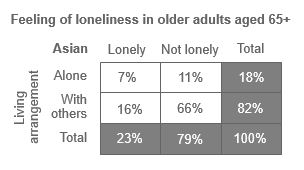Profile of ethnicity, living arrangements and loneliness amongst older adults in Aotearoa New Zealand: A national cross-sectional study
Authors
Hamish Jamieson, Helen Gibson, Rebecca Abey-Nesbit, Annabel Ahuriri-Driscoll, Sally Keeling and Philip Schluter
Author affiliations
University of Otago, University of Canterbury
Publication
Australasian Journal of Ageing, vol. 37(1), pp. 68-73, March 2018
Methodology
Conducted an analysis of data collected between September 2012 and January 2016 from New Zealand's universal standardized comprehensive geriatric assessment (interRAI-HC) to understand the associations between loneliness and both ethnic groups and living arrangements for older adults aged 65+.
Results
"Most stated that they were not lonely (79%), but those living alone were more likely to be lonely (29%) than those living with others (14%). Amongst those living alone, significant differences in the likelihood of being lonely emerged between ethnic groups."
Conclusion
"The finding that feelings of loneliness were highest amongst Asian older adults, particularly those who lived with others, appears to contradict the assumptions that collectivity or interdependence and cohabitation guard against social isolation and the absence of companionship or meaningful relationships."
InterRAI-HC
The national interRAI-HC (International Residential Assessment Instrument-Home Care) is used to assess all New Zealand community-dwelling older adults who are being considered for access to residential care or publicly funded community services.
During the assessement period there were responses from 71,859 eligible participants. Loneliness was self-assessed with a binary measure of whether participants ‘reported feelings of loneliness’.
Feeling of loneliness in older adults aged 65+
The data provided a useful comparison of the subjective measure of loneliness with the objective measures of living arrangement and ethnicity.
Given European (including Other) made up 89% of the eligible participants, the profile of all the participants is very similar to that for European*.

European*
Over half of the European participants lived alone. Given European (including Other) made up 89% of the eligible participants, the profile of all the participants was very similar to that for European*.

Māori
The prevalence of loneliness for Māori older adults was similar to European*. Unlike European*, most Māori participants lived with others. As a consequence, slightly higher proportion of participants who were lonely lived with others than lonely lived alone.

Asian
Asian older adults had the highest loneliness rate of any ethnicity, even though most lived with others. Surprisingly, more than two-thirds of participants who were lonely lived with others.

Pasifika
Pasifika had the lowest loneliness rate. This is consistent with the Stats NZ General Social Surveys. Surprisingly, more than three quarters of participants who were lonely lived with others.
A limitation of the research was the limited data sets for non-European older adults, even though the dataset reflected the general ethnic population distribution of older adults. A further limitation of the research was the binary variable used to self-assess perceived loneliness. The generalisability of the results was limited because no potential confounding factors (i.e. depression, cognition, age, sex and other markers of health status) that could influence the variables and subsequent results had been included in the analysis.
The national interRAI-HC data for 2017 was released to the Herald on Sunday on 8 April 2018 (Nicholas Jones, ‘Lonely New Zealand: A third of elderly spend their days alone’). According to the report, of the 37,000 seniors assessed in 2017, 22% reported feelings of loneliness (as compared to the 21% in the research paper). Waitemata, MidCentral and Whanganui DHBs had the highest proportion of lonely seniors, at 28%.
